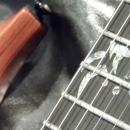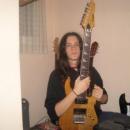en una busqueda rapida con el amigo google:
"In solids, the velocity of sound is usually greater than in liquids. It may be calculated from the formula
V = sqrt(E/ D)
when the elasticity E and density D of the solid are known.
The various experimental methods that have been employed for determining it, will be given later on. The following are some of the principal determinations made by Weitheim.
Lead 4,030 feet per second at 20º C.
Gold 5,717 " " " " "
Silver 8,553 " " " " "
Copper 11,666 " " " " "
Platinum 8,815 " " " " "
Iron 16,822 " " " " "
Steel 16,357 " " " " "
Wood (along fibre)from 10,000 to 15,000 " " "
(across fibre) 3,000 to 5,000 " " "
The superior conducting power of elastic solids may be illustrated by a variety of experiments. Thus, strike a tuning-fork and place the stem against the end of a rod of wood 12 or 15 feet long. So perfect is the transmission, that if a person applies his ear to the other end, the sound will appear to come from that part of the rod. A still better result is obtained by placing one end of the rod against a door panel, and applying the vibrating tuning fork to the other. Again, place a watch well between the teeth, without however touching them, and note the loudness of its tick. Now gently bite the watch, and observe how much more plainly it can be heard. In the first case, the vibrations pass through the air to the ears, in the second case, through the solid bones of the skull. This is the principle of the audiphone.
"
fuente http://pondscienceinstitute.on-rev.com/svpwiki/tiki-index.php?page=02+-+The+Transmission+of+Sound
"In solids, the velocity of sound is usually greater than in liquids. It may be calculated from the formula
V = sqrt(E/ D)
when the elasticity E and density D of the solid are known.
The various experimental methods that have been employed for determining it, will be given later on. The following are some of the principal determinations made by Weitheim.
Lead 4,030 feet per second at 20º C.
Gold 5,717 " " " " "
Silver 8,553 " " " " "
Copper 11,666 " " " " "
Platinum 8,815 " " " " "
Iron 16,822 " " " " "
Steel 16,357 " " " " "
Wood (along fibre)from 10,000 to 15,000 " " "
(across fibre) 3,000 to 5,000 " " "
The superior conducting power of elastic solids may be illustrated by a variety of experiments. Thus, strike a tuning-fork and place the stem against the end of a rod of wood 12 or 15 feet long. So perfect is the transmission, that if a person applies his ear to the other end, the sound will appear to come from that part of the rod. A still better result is obtained by placing one end of the rod against a door panel, and applying the vibrating tuning fork to the other. Again, place a watch well between the teeth, without however touching them, and note the loudness of its tick. Now gently bite the watch, and observe how much more plainly it can be heard. In the first case, the vibrations pass through the air to the ears, in the second case, through the solid bones of the skull. This is the principle of the audiphone.
"
fuente http://pondscienceinstitute.on-rev.com/svpwiki/tiki-index.php?page=02+-+The+Transmission+of+Sound







 Frasco
Frasco 





